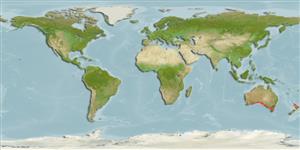Common names from other countries
Environment: milieu / climate zone / depth range / distribution range
Ökologie
seewasser; brackwasser demersal; tiefenbereich 1 - 100 m (Ref. 9563). Temperate; 30°S - 43°S
Indo-Pacific: known only from southern Australia.
Length at first maturity / Size / Gewicht / Alter
Maturity: Lm 23.5 range ? - ? cm
Max length : 46.0 cm TL Männchen/unbestimmt; (Ref. 9563); max. veröff. Gewicht: 3.1 kg (Ref. 6390)
Kurzbeschreibung
Morphologie | Morphometrie
Wirbelzahl: 18 - 20. This species differs from Platycephalus westraliae in having the following characters: both second dorsal and anal fin rays usually 14 (vs. 13), total gill rakers 18-20 (vs. 10); palatine with a tooth band comprised of several irregular rows of conical teeth (vs. with an inner larger conical and an outer smaller villiform tooth rows); caudal fin with several small pale brown spots on the upper lobe and one or two large dark brown or black spots on the lower lobe, and with concave posterior margin (vs. with 3 dark bands and with mostly straight posterior margin) (Ref. 86914).
Inhabit coastal waters from shallow bays and inlets to depths of about 100 m over sand, shell grit and mud substrates (Ref. 6390). Sand flathead are usually solitary but may form loose aggregations (Ref. 2165, 27247). They sometimes move long distances (Ref. 6390). They are active foragers and ambush predators (Ref. 6390), occasionally are scavengers (Ref. 6390). Feed on crustaceans and fish (Ref. 2165). Its fin spines are venomous, can inflict mild to severe pain (Ref. 125684).
Paxton, J.R., D.F. Hoese, G.R. Allen and J.E. Hanley, 1989. Pisces. Petromyzontidae to Carangidae. Zoological Catalogue of Australia, Vol. 7. Australian Government Publishing Service, Canberra, 665 p. (Ref. 7300)
IUCN Rote Liste Status (Ref. 130435)
CITES (Ref. 128078)
Not Evaluated
Nutzung durch Menschen
Fischereien: kommerziell
Mehr Information
ReferenzenAquakulturAquakultur ProfilZuchtlinienGenetikElectrophoresesVererbbarkeitKrankheitenVerarbeitungMass conversion
PartnerBilderStamps, Coins Misc.LauteCiguateraGeschwindigkeitSchwimmstilKiemenoberflächeOtolithsGehirngrößeSehfähigkeit
Tools
Zusatzinformationen
Download XML
Internet Quellen
Estimates based on models
Preferred temperature (Ref.
115969): 14.6 - 18.5, mean 17.1 (based on 242 cells).
Phylogenetic diversity index (Ref.
82804): PD
50 = 0.5000 [Uniqueness, from 0.5 = low to 2.0 = high].
Bayesian length-weight: a=0.00490 (0.00381 - 0.00630), b=3.06 (2.98 - 3.14), in cm Total Length, based on LWR estimates for this species (Ref.
93245).
Trophic level (Ref.
69278): 4.3 ±0.75 se; based on food items.
Widerstandsfähigkeit (Ref.
120179): mittel, Verdopplung der Population dauert 1,4 - 4,4 Jahre. (K=0.19; tmax=9).
Fishing Vulnerability (Ref.
59153): Low to moderate vulnerability (29 of 100).
